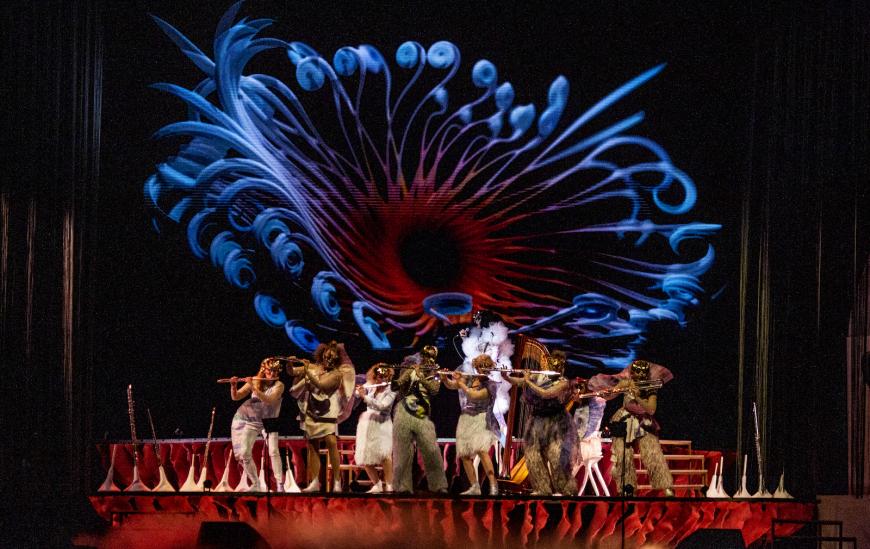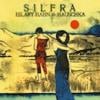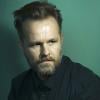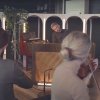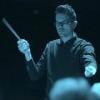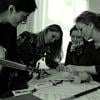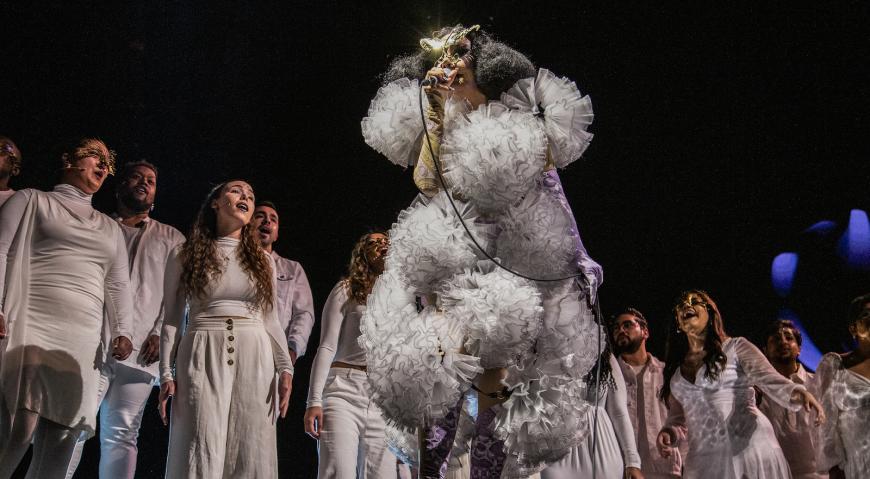
I’d never been to the Chase Center, and never listened much to the music of Björk. Last Saturday was the time to find out what I’d been missing.
For a venue with a seating capacity of nearly 20,000 for concerts — 18,000 for athletic events — the Chase presented a remarkably user-friendly design, its ample but gently curved interior seeming welcoming rather than forbidding,
The crowd cheered the entrance of the white-garbed choir Tonality, though it’s a safe bet that most of the fans were not as familiar with the L.A.-based ensemble as I was, having watched numerous of their YouTube videos, themed around the same sorts of social issues which Björk herself addresses in lyrics and interviews. Tonality’s repertoire also includes Monteverdi and Bach, as well as R&B and gospel.
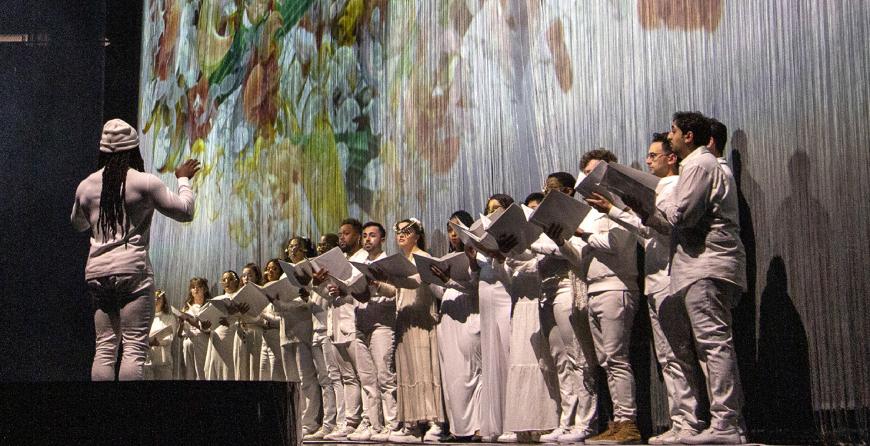
As Cornucopia’s opening act, the 18-member choir performed the two-part New Collective Consciousness, composed and arranged by Joseph Trapanese for the group’s second album, America Will Be (Aerocade Music, 2021). The lyrics of “We Know” were translated from a plaque placed at the site of a disappeared glacier in Iceland, with words by documentary filmmaker Andri Snær Magnason, born, as was Björk, in Reykjavík. The pitch-perfect choir deployed the syllables of the ecological warning artfully. In the longer “How Dare You,” taken from 2019 speeches by Swedish teenage ecological activist Greta Thunberg, Tonality more impressively showcased its luminous voicings and dramatic dynamic range, with Trapanese’s colorings rather evocative of Ned Rorem.
To the home site of the basketball exploits of the Golden State Warriors, Björk brought her own team, assembled for Cornucopia, her 10th concert tour and first theatrical production in a career she began with an eponymous recording at age 11, in 1976. Now helping realize her ever-idiosyncratic visions on a grand scale are media artist Tobias Gremmier, set designer Chiara Stephenson, costumer Olivier Rousteing, and director and filmmaker Lucrecia Martel.
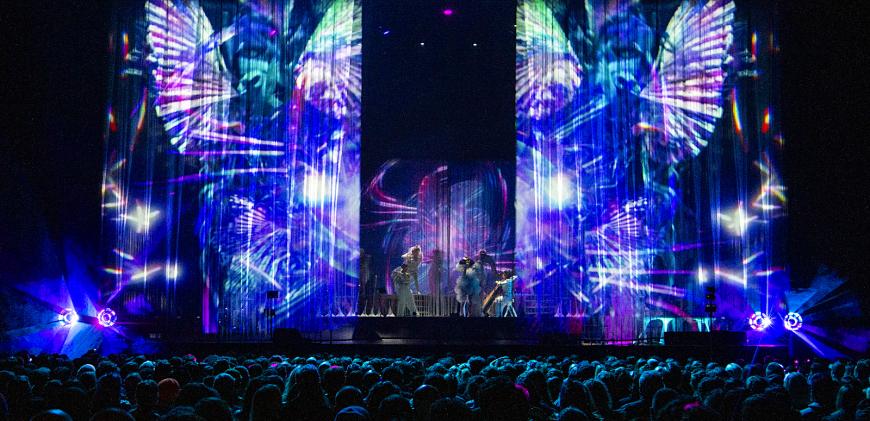
Loudly acclaimed by her thousands of local fans, Björk made her appearance wearing a sci-fi headdress and what Rousteing had envisioned as a sort of human bouquet of seeding dandelions. For the most part, her live material for Cornucopia was drawn from her most recent album Utopia (2017, on the One Little Independent label), with additional songs from Medulla (2004), Vespertine (2001), and Debut (1993). She was joined on stage for the title track “Utopia” by Viibra, an all-female flute ensemble from Iceland.
In both her movements and her vocalization, Björk sustained spontaneity and eschewed anything like coordinated choreography and classical voice training; she was more a shouter than a singer, airy, breathy, and at times affectingly childlike. In person, I came to better realize how her instrument fits her poetic, visionary lyrics. Partly because of Björk’s ethereal vocal quality, partly because of an accent combining Icelandic influence with Estuary English, and partly because of the aural mass of her musical accompaniment, particularly the electronica and ambient sound, it’s difficult to discern her lyrics while she’s singing them.
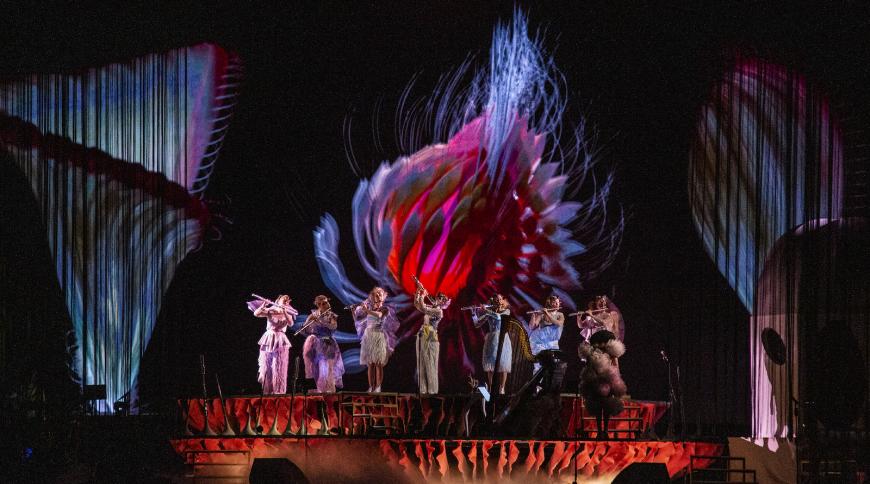
On “Show Me Forgiveness” and several later songs, Björk secreted herself in an egg-like reverb chamber, custom-made by the engineering firm Arup. The production of the soulful “Blissing Me” provided engaging changeups, including percussionist Manu Delago, at an aquarium at stage left, audibly cascading water from pumpkin-shell bowls, then inverting them as water drums. Björk dueted here with vocalist serpentwithfeet (aka Josiah Wise), whose words were notably easier to make out.
There followed what was tabbed as a First Interlude, with an instrumental titled “Arpeggio.” (Arpeggiation is one of Björk’s trademarks.) Birdsong and flute accompanied projected words from Greta Thunberg, while mammoth ovoid undulations were projected on a rear screen. For “Body Memory,” the projection of writhing humanoids fit some of Björk’s most sexually explicit (but not particularly intelligible) lyrics. This number featured potent onstage musical support from Tonality, who swayed as they sang, and from an instrument called the circle flute, assembled as four conjoined flutes, requiring four coordinated flautists, created by Parisian flute maker Yves Roosen. Both aural and visual layering were irresistibly fascinating throughout this long composition.
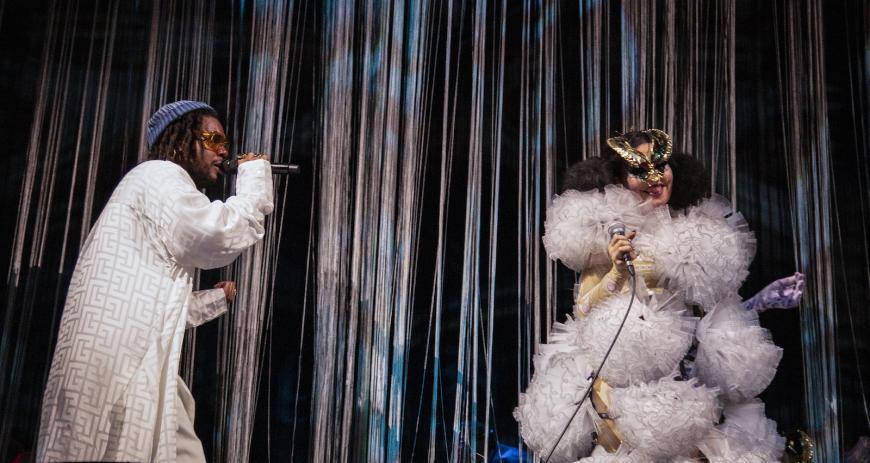
On “Hidden Place,” Tonality neatly negotiated the tricky syncopation and phrasing. They remained for “Mouths Cradle,” on which Delago played a double-headed cylindrical drum, providing a regularity of pulse rarely heard in other numbers. The contrast between the classically-sourced focus and gravitas of the choir singers and sylphic sound of the headliner was in evidence, and somehow effective. The members of Viibra served temporarily in similar fashion on “Pagan Poetry.” The harp of Katie Buckley, a featured collaborator in Cornucopia and many of Björk’s live performances, enhanced the yearning.
Gremmier’s digital imagery, projected variously on a curtain of narrow hanging translucent ropes at the front of the stage and on a rear screen, is psychedelically entrancing and breathtaking, whatever you may or may not have taken ahead of time. Over the course of Cornucopia’s 21 musical numbers, the brightly colored images were often sourced in nature, others in sensual anatomy. For “Losss,” they were drawn from one of the music videos accompanying the launch of Utopia in 2017.
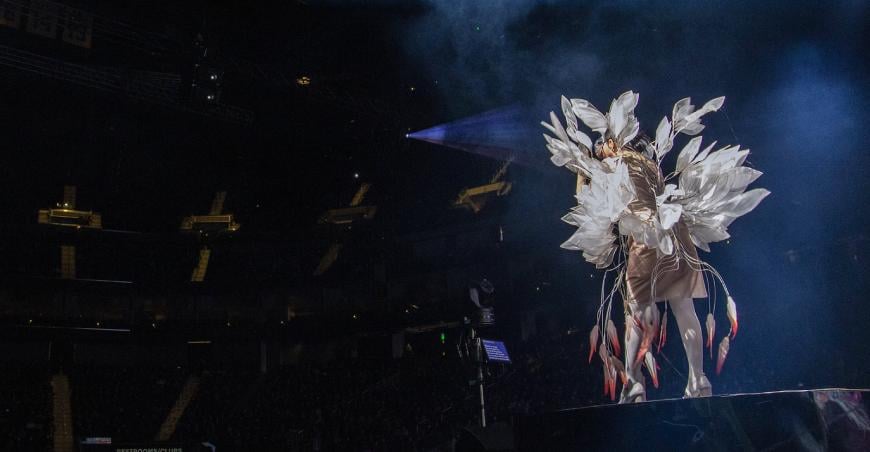
“Sue Me,” another song from that album, is among Björk’s autobiographical creations, this one relating to her battle with her former partner over custody of their daughter. Many of Björk’s melody lines traverse minor mode primary chords. But with “Tabula Rasa,” which brought back Tonality and the flutes, the musical setting was more complex and perhaps closer to classical than anything else on the evening’s program. Björk’s refreshingly tender voice convincingly announced a “time for women to rise” and an assurance that, “you are strong.”
The Second Interlude featured Greta Thunberg, her fresh and forthright face projected a hundred feet high on the rope curtain, delivering her speech at the UN’s COP24 climate talks. Björk’s encores, bolstered by Tonality, followed in suit, with “Future Forever” vowing to “hold forth for love forever” and “Notget,” a kind of bolero, assuring that “love will keep us safe from death.”
After this tour ends, Björk will complete work on her 10th studio album, meant for people who are “making clubs at home, in their living rooms,” she says.
